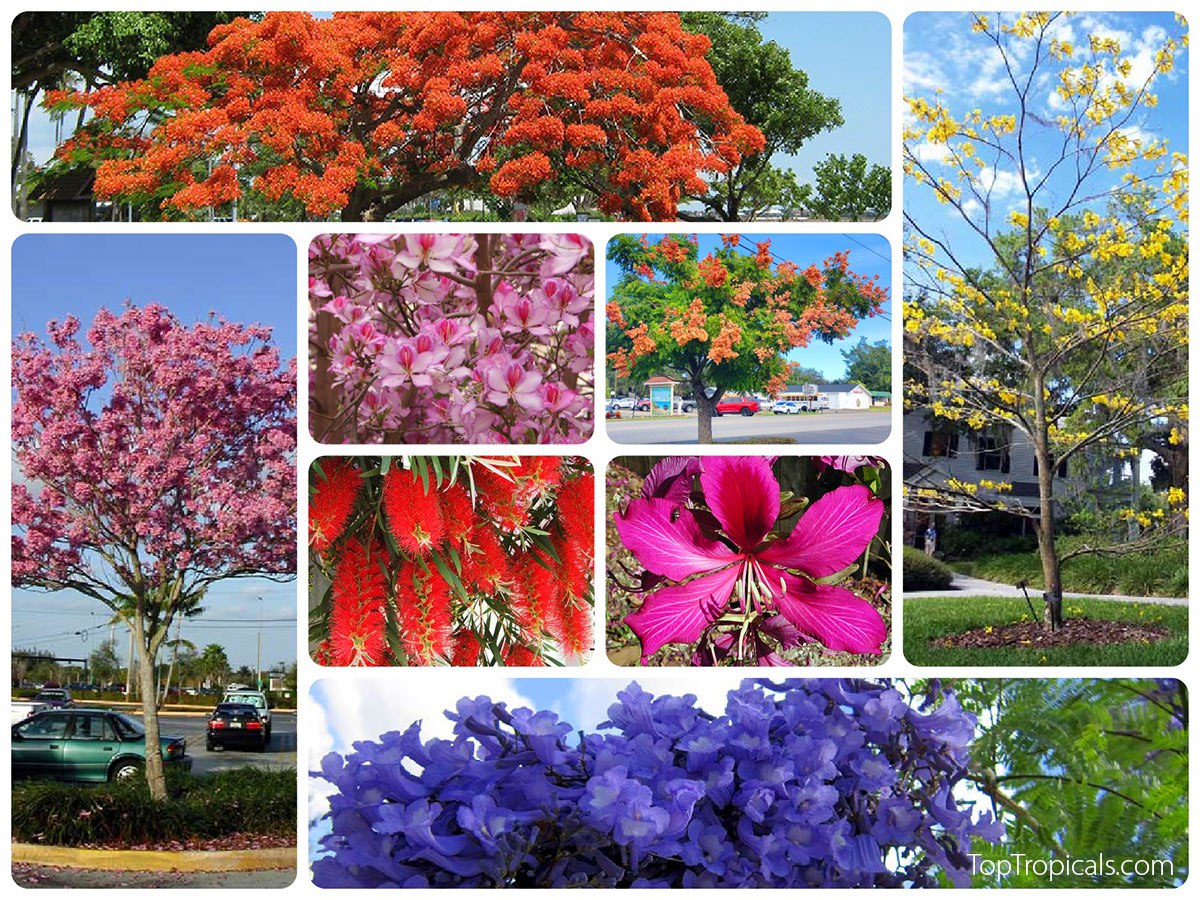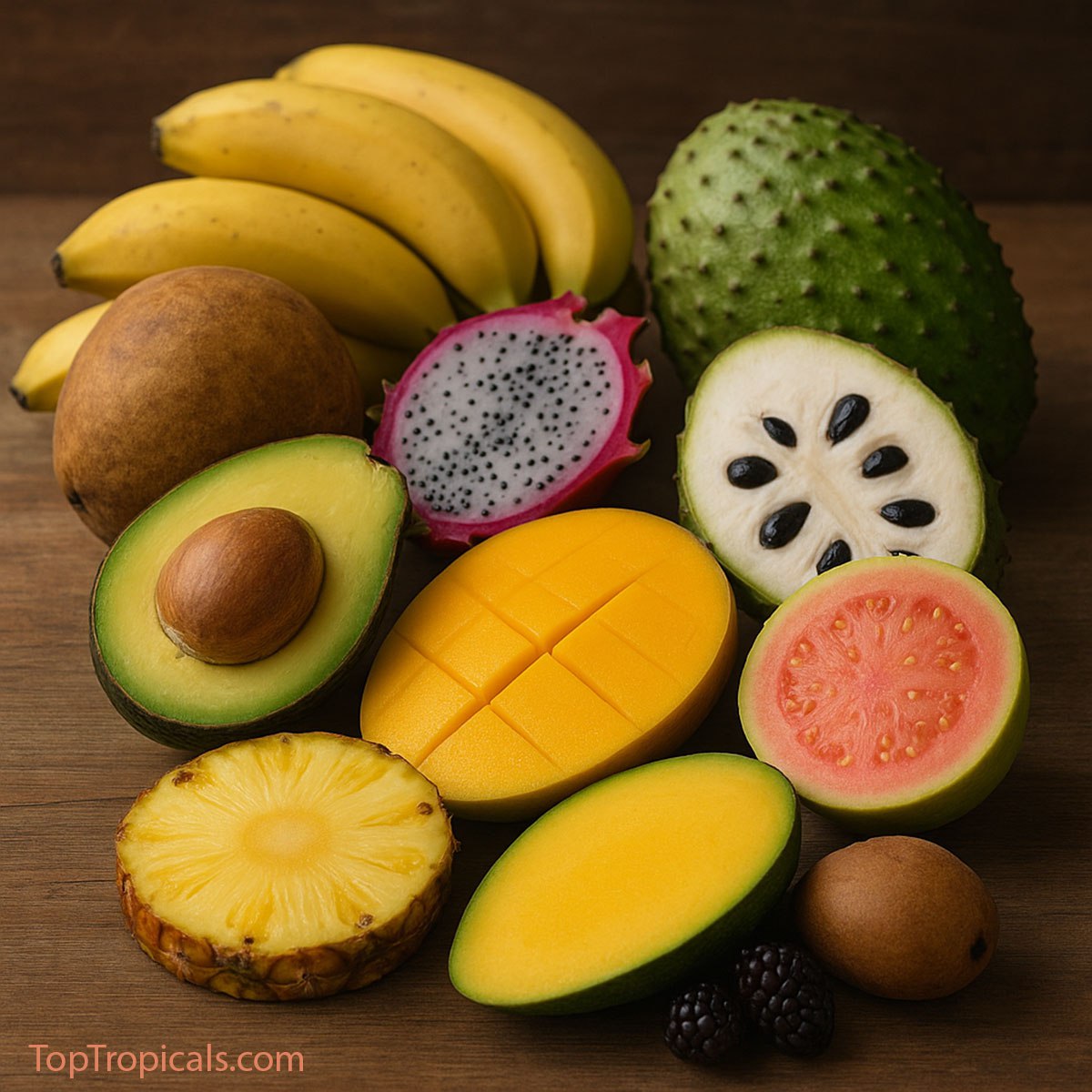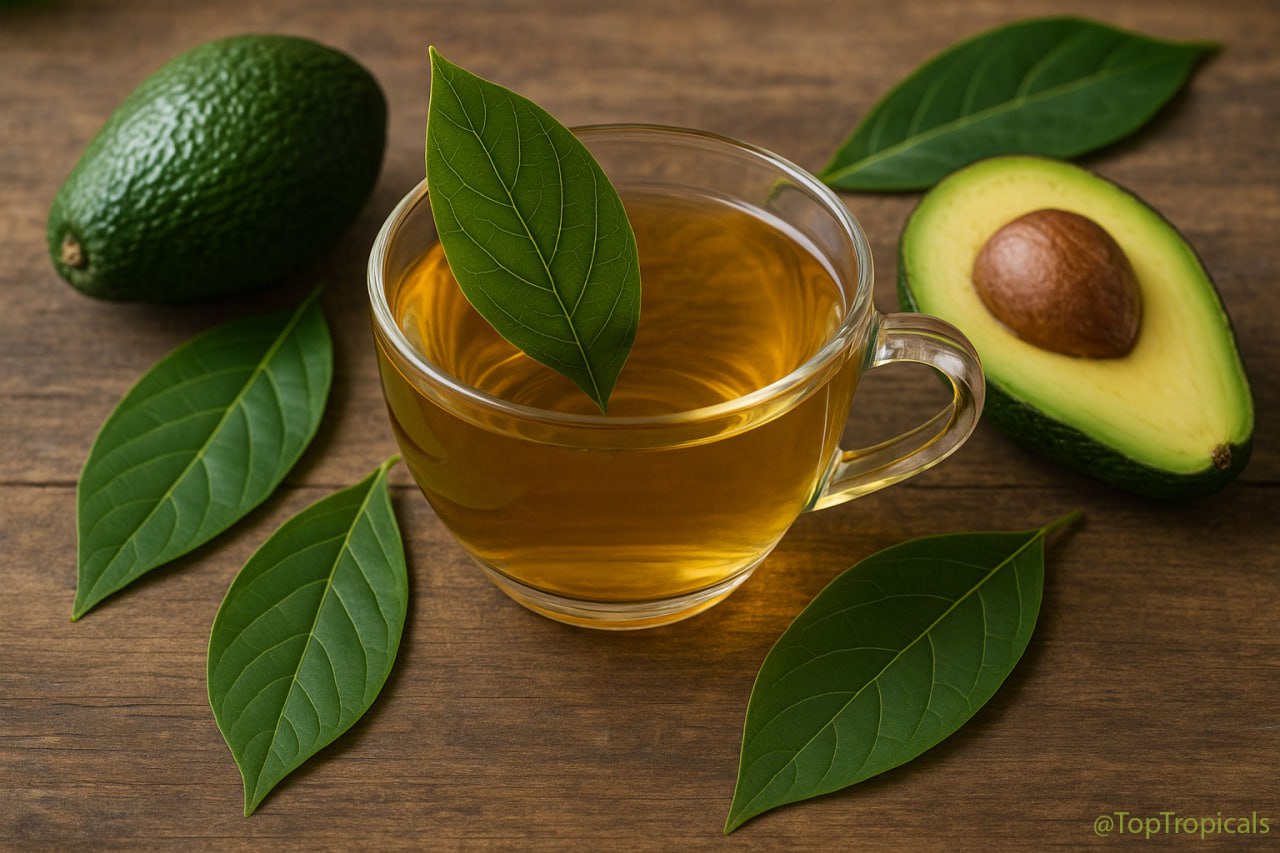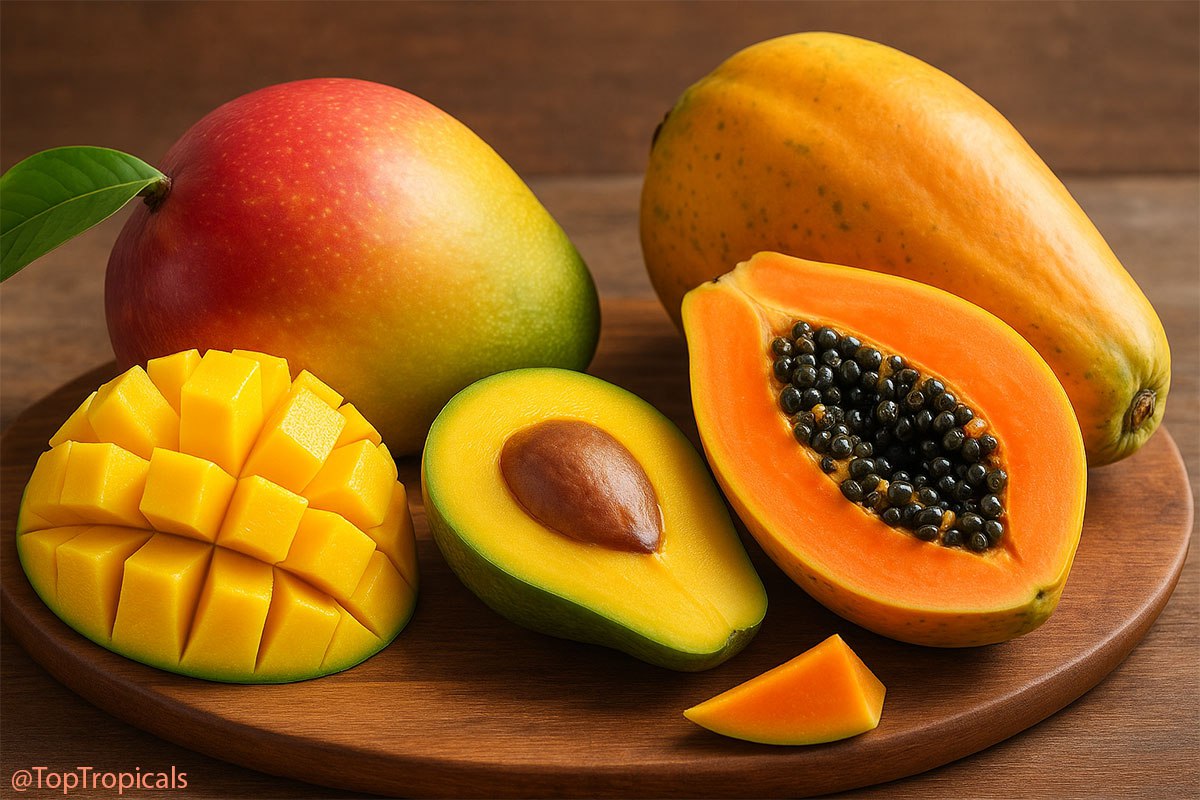Garden Blog - Top Tropicals
Guava beats banana in the potassium game
- 🍉Everyone talks about bananas when it comes to potassium, but guava (Tropical Guava - Psidium guajava) quietly beats them! One cup of guava packs around 688 milligrams of potassium, compared to about 450 in a banana!
- 🍉Potassium is essential for strong bones, steady blood pressure, muscle function, and a healthy nervous system. Adults need between 2,600 and 3,400 mg daily, according to the National Institute of Health - so adding guava to your fruit bowl is a smart move.
- 🍉Guavas are common across the tropics - from Mexico to the Caribbean - with green or yellow skin and beautiful pink or off-white flesh. Sweet, aromatic, and easy to grow in warm climates, guava is one tropical fruit that truly earns its place in the garden and on your plate.
🛒 Your body needs potassium - your garden grows it on guava tree!
📚 Learn more:
- ▫️Six guava varieties that will keep you picking year-round
- ▫️How to grow a Guava Tree: Practical Guide to Growing Guava
- ▫️More about #Guava
#Food_Forest #Guava #Discover
🟢 Join 👉 TopTropicals
11 tropical fruits to eat instead of taking a fiber supplement
- When we think of tropical fruit, we picture sweetness, sunshine, and exotic flavors packed with vitamin C. But beneath all that juicy goodness lies another gift: dietary fiber - quietly working to support digestion, feed the gut microbiome, and help keep blood sugar steady.
- Avocado leads the pack among tropical fruits for fiber content. One creamy, ripe fruit can provide around 10 grams of fiber, roughly a third of an adult’s daily need. And there’s more to avocado than fiber - it’s also rich in healthy fats, micronutrients, and that silky texture everyone loves.
- Other tropical fruits bring their own kind of fiber strength. Guava delivers up to 9 grams per cup, plus a burst of vitamin C.
- Mango offers about 3 grams in half a fruit, especially when eaten with some of the skin.
- Pineapple, though not always seen as a fiber powerhouse, still contributes around 2 grams per cup, along with bromelain, the enzyme that helps digestion.
- Jackfruit’s fibrous pulp makes it another standout - it’s so meaty, it’s even used as a plant-based substitute in savory dishes.
- Sapote fruit (Mamey, Canistel) and Sapodilla add fiber with a smooth, custard-like texture.
- Adventurous tropical varieties like Annona (custard apple, soursop) may not top the charts in fiber numbers, but their soft, fibrous flesh still adds value: about 1.3 grams of fiber per 100 grams of fruit.
- Bananas contain both soluble and insoluble fiber; the soluble part (mainly pectin) helps control blood sugar and appetite, while the insoluble fiber aids regularity.
- Mulberries are rich in insoluble fiber, especially in their skin, supporting digestion and promoting healthy bowel movements.
- Dragon fruit offers a mix of soluble fiber in its juicy flesh and insoluble fiber from its tiny edible seeds, which help support gut health and feed good bacteria.
These fruits aren’t just delicious - they help you meet your daily fiber needs in ways that are far more enjoyable (and sustainable) than taking supplements. And when home gardeners, farmers, or tropical communities grow and share them, it’s a double win: nutrition and tradition hand in hand.
✔️ Tropical fiber power: tips for getting more fiber from tropical fruits
- ⏺Eat whole, not juiced. Most of the fiber is in the pulp, skin, and seeds. Juicing removes much of that goodness.
- ⏺Mix it up. Tropical fruits are great, but balance them with legumes, whole grains, nuts, and veggies for a full fiber range.
- ⏺Take it slow. If your diet is low in fiber, increase gradually to avoid bloating or discomfort.
- ⏺Drink plenty of water. Fiber works best when paired with hydration.
- ⏺Mind the ripeness. Unripe fruits can have more resistant starch, another form of fiber.
- ⏺Get creative. Toss tropical fruits into smoothies, salsas, breakfast bowls, or even desserts - a tasty stealth-fiber strategy.
🛒 Plant a fruit tree to harvest your fruit tomorrow
📚 Learn more:
Tropical fruit health benefits guide - what fruit and edibles can help with health issues and vitamin deficiencies, Part 1 and Part 2.
#Food_Forest #Remedies #Discover #How_to
🟢 Join 👉 TopTropicals
Avocado leaf tea: island secret for a calm heart and blood pressure
🍃 You see that Avocado tree in your yard? Don't just love it for the fruit - the leaves carry magic too! Old folks in the tropics will tell you - never throw away the avocado leaves. They’ve been used for generations to brew a tea that helps steady the heart and ease high blood pressure.
🍃 When life gets busy and your heart starts beating too fast, this tea helps it find its rhythm again. The leaf holds flavonoids and quercetin - fancy words for what nature been doing all along: keeping the blood flowing smooth and the body at peace. Folks say it also helps with digestion and keeps the liver happy.
🍃 Avocado leaf tea
Ingredients
- 3 to 4 fresh avocado leaves
- 2 cups water
- Optional: honey, lemon, or cinnamon stick
Instructions
- Rinse the avocado leaves well.
- Place them in a small pot with 2 cups of water.
- Bring to a gentle simmer and let it cook for about 10 minutes.
- Strain the tea and add honey, lemon, or cinnamon if desired.
- Sip slowly and enjoy the calm, earthy flavor.
- 🍃 They say it helps the belly, calms the mind, and keeps the liver strong. Maybe that’s science, maybe it’s just island truth - but it surely does the body good! Some call it bush medicine, others just call it good sense. Either way, it’s a simple garden remedy that’s been soothing hearts long before pills and prescriptions came around.
🛒 Plant an Avocado tree and help your body stay healthy
📚 Learn more:
Tropical fruit and plants that help keep blood pressure in balance, Part 1, and Part 2.
#Food_Forest #Remedies #Discover #How_to
🟢 Join 👉 TopTropicals
Yes, you can grow a tropical fruit tree in a pot!
🍒 If you dream of picking fresh tropical fruit - Mango, Avocado, exotiс Annona and more - but only have a patio, balcony, or small yard, you’re not out of luck. Many tropical fruit trees grow perfectly well in large containers. The key is choosing the right variety, pot, and care routine.
🍒 Pick a compact tree type
🍒 Choose the right pot
🍒 Soil and watering
🍒 Light and feeding
🍒 Cold protection and pruning
Start with a dwarf or semi-dwarf variety. Regular tropical trees can grow huge, but container-sized cultivars stay under 8–10 feet and are much easier to manage. For example, Condo varieties of Mango like Pickering or Ice Cream stay small and still produce full-sized fruit. The same goes for Dwarf Avocados like Wurtz (also called Little Cado) and Sugar apples. Blackberry Jam fruit tree (Randia formosa) and Peanut Butter Fruit tree (Bunchosia argentea) are also excellent choices.
Begin with a 5-gallon container and move up as the tree grows. A mature plant will be happy in a 20–25-gallon pot. Drainage is critical - roots will rot if the pot stays soggy. Use a sturdy plastic, ceramic, or wooden container with multiple holes in the bottom.
These trees all like loose, well-draining soil. Mix potting soil with perlite or pine bark for better aeration. Water deeply but not too often - let the top few inches dry before watering again. Overwatering is the quickest way to kill a potted tropical.
Full sun is a must - aim for at least 6 hours daily. Fertilize during the growing season with a balanced fruit tree or slow-release fertilizer like Green Magic or liquid Sunshine Boosters. Many tropicals appreciate an extra boost of micronutrients like iron and magnesium to keep their leaves green.
If you live where winters get chilly, move the pot indoors or into a greenhouse before frost. Prune lightly in spring to keep shape and airflow. Container trees can fruit heavily if given light, warmth, and consistent care.
At the end of the day, container culture lets you grow the tropics anywhere - from a city balcony to a backyard deck.
➡ Next: The best tropical fruit trees for containers...
📸 Growing and fruiting Soursop in apartment (PDF download)
🛒 Explore tropical fruit trees
#Food_Forest #How_to #Discover
🟢 Join 👉 TopTropicals
Ten shrubs you need to have for winter colors
Garlic Vine, Dombeya - Tropical Hydrangea, Brunfelsia Yesterday-Today-Tomorrow, Fountain Clerodendrum, Tibouchina grandifolia - Glory bush, Chinese hat, Barleria - Philippine violet, Thunbergia - Kings Mantle, Eranthemum - Blue Sage or Lead Flower, Petrea vine - Queens wreath
Many snowbirds ask what to plant when they’re here just for the season. The answer is simple: go for trees and shrubs that bloom in winter. Fall is the perfect time to get them in the ground so your garden will be bursting with flowers once the cool season arrives. In our earlier video, we shared 8 best flowering trees that will bloom for you in Winter. Now, here are the shrubs that will complete your colorful winter garden.
- 🌷 1. Mansoa alliacea - Garlic Vine
- 🌷 2. Dombeya wallichii - Tropical Hydrangea
- 🌷 3. Brunfelsia pauciflora Compacta - Dwarf Yesterday-Today-Tomorrow
- 🌷 4. Clerodendrum minahassae - Fountain Clerodendrum
- 🌷 5. Tibouchina multiflora (grandifolia) - Glory bush, Quaresmeira
- 🌷 6. Holmskioldia sanguinea - Red Chinese hat
- 🌷 7. Barleria cristata - Philippine violet
- 🌷 8. Thunbergia erecta - King’s Mantle
- 🌷 9. Eranthemum pulchellum - Blue Sage, Lead Flower
- 🌷 10. Petrea volubilis (racemosa) - Queen’s wreath
Known for its garlicky scent, it also puts on clusters of lavender to purple flowers in cool weather. Reliable and eye-catching, often trained on fences or trellises. 👉plant it
Large pink pompom clusters hang like lanterns from the branches. Sweetly fragrant and showy, it creates a hydrangea effect right in winter. 👉plant it
Small and manageable, it opens purple flowers that fade to lavender and then white, giving the look of three colors at once. A cheerful winter bloomer for pots or borders. 👉plant it
This shrub lives up to its name with cascades of long white flower sprays, blooming heavily in the cooler months and brightening shaded corners. 👉plant it
Covered in clusters of soft, fuzzy purple blooms, this shrub adds tropical flair during the cooler months. Its velvety leaves are ornamental year-round. 👉plant it
Cup-shaped bracts form red “hats” around small flowers. This shrub stands out with unique form and long-lasting blooms. 👉plant it
A hardy shrub with masses of purple-violet blooms in the cool season. It flowers when many plants are quiet, adding dependable winter color. 👉plant it
A compact shrub with velvety purple blooms and bright yellow throats. It’s neat, easy to manage, and flowers generously in winter. 👉plant it
Few shrubs can match its electric-blue spikes of flowers in winter. Compact and low-care, it brings a rare color to the cool season garden. 👉plant it
A woody vine-shrub that bursts into cascading sprays of lavender stars. It flowers heavily in winter, resembling wisteria in the tropics. 👉plant it
🛒 Explore Winter bloomers
📚 Learn more:
- ▫️8 best flowering trees that will bloom for you in Winter
- ▫️9 best tropical shrubs that bloom all summer long or year around
- ▫️4 best low-growing perennials that bloom all summer
#Hedges_with_benefits #Discover
🟢 Join 👉 TopTropicals
Can you name all the fruits on this tray? One of them will stump you!
Papaya, Avocado, Egyptian guava and Cas guava, Barbados cherry, Peanut butter fruit
- This morning I walked the garden and came back with a tray of fruits! That’s the joy of living in Florida with your own tropical garden: something new is always in season.
- On today’s tray: Papaya, Avocado, Egyptian guava and Cas guava, Barbados cherry… And this little red one? Peanut butter fruit!
- At Top Tropicals, you’ll find every tropical fruit tree you can imagine. What fruits are you harvesting from your garden right now?
🛒 Explore rare tropical fruit
📚 Learn more:
- ▫️10 best fruit trees to grow in Florida and Southern landscapes
- ▫️Five best fruit trees to plant in Summer
- ▫️Top 10 fast-fruiting trees
#Food_Forest #Discover
🟢 Join 👉 TopTropicals
8 best flowering trees that will bloom for you in Winter

Royal poinciana - Flamboyant tree, Delonix regia (top) Tabebuia impetiginosa - Dwarf Pink Tabebuia (left) Tabebuia chrysotricha - Dwarf Golden Tabebuia (right) Bauhinia variegata - Pink Butterfly Orchid Tree (center top left) Koelreuteria paniculata - Golden Rain Tree (center top right) Callistemon citrinus - Weeping Red Bottlebrush (center bottom left) Bauhinia blakeana - Hong Kong Orchid Tree (center bottom right) Jacaranda mimosifolia (acutifolia) (bottom)
📸 Pictures for the previous post:
Royal poinciana - Flamboyant tree, Delonix regia (top)
Tabebuia impetiginosa - Dwarf Pink Tabebuia (left)
Tabebuia chrysotricha - Dwarf Golden Tabebuia (right)
Bauhinia variegata - Pink Butterfly Orchid Tree (center top left)
Koelreuteria paniculata - Golden Rain Tree (center top right)
Callistemon citrinus - Weeping Red Bottlebrush (center bottom left)
Bauhinia blakeana - Hong Kong Orchid Tree (center bottom right)
Jacaranda mimosifolia (acutifolia) (bottom)
🛒 Plant a tree now for winter flowers
#Trees #Discover
🟢 Join 👉 TopTropicals
Eight most spectacular winter blooming trees
Eight most spectacular winter blooming trees
🍁 Fall is the right time to get winter bloomers in the ground. Plant them now, and by the time the cool season settles in, you’ll have flowers to enjoy. We get a lot of snowbirds asking us what to plant when they’re here for just the season, and the answer is simple: pick trees and shrubs that show off in winter!
🏆 8 best flowering trees that will bloom for you in Winter
- 💐1. Royal poinciana - Flamboyant tree, Delonix regia
Known for fiery red-orange blooms, the flamboyant tree creates a spectacular canopy. Even in the cooler season, mature specimens may flower heavily in warm climates.
👉 Learn more
- 💐2. Tabebuia chrysotricha - Dwarf Golden Tabebuia
One of the brightest winter bloomers, this small tree bursts into golden-yellow flowers on bare branches, turning the whole crown into a glowing dome.
👉 Learn more
- 💐3. Tabebuia impetiginosa - Dwarf Pink Tabebuia
A smaller tabebuia with trumpet-shaped pink to lavender blooms. Its leafless winter display is striking and well-suited for compact gardens.
👉 Learn more
- 💐4. Jacaranda mimosifolia (acutifolia)
Famous for its lavender-blue clouds of trumpet flowers, Jacaranda puts on a dramatic show even when most trees are bare. Perfect for lining streets or as a specimen tree.
👉 Learn more
- 💐5. Koelreuteria paniculata (bipinnata) - Golden Rain Tree
This tree stands out in winter with clusters of golden flowers followed by papery lantern-like seed pods. It’s ornamental in every stage, even when not in full bloom.
👉 Learn more
- 💐6. Callistemon citrinus - Weeping Red Bottlebrush
Its crimson brush-like flowers appear in flushes during the cooler months. This tree is tough, drought-tolerant, and attracts pollinators while keeping color in the winter garden.
👉 Learn more
- 💐7. Bauhinia variegata - Pink Butterfly Orchid Tree
Soft pink to lavender blooms open on leafless branches in the cool season. The butterfly-shaped petals make this tree both graceful and eye-catching.
👉 Learn more
💐8. Bauhinia blakeana - Hong Kong Orchid Tree
A sterile hybrid that doesn’t produce seed, this tree is prized for its huge magenta flowers that cover bare branches in winter. Rare and highly ornamental, it’s a true collector’s tree.
🛒 Plant a tree now for winter flowers
#Trees #Discover
🟢 Join 👉 TopTropicals
How to make lots of Insulin Ginger plants quickly and get more health benefits
Costus igneus (Chamaecostus cuspidatus) - Fiery Costus or Spiral Flag
- Costus igneus (Chamaecostus cuspidatus) - Fiery Costus or Spiral Flag is believed to help lower blood glucose levels naturally and managing diabetes.
- Have you heard of Insulin Ginger? Everyone wants to have it in the garden!
- Gardeners in India grow it not just for its pretty spiral leaves, but for what those leaves do. People with diabetes often chew them fresh or brew them into tea, saying it helps keep their blood sugar under control.
- Researchers have found something interesting: the leaves contain an insulin-like compound, along with antioxidants and anti-inflammatory properties. In animal studies, extracts from the plant lowered blood sugar, protected the liver and kidneys, and even made the body more sensitive to insulin.
- The way folks use it is simple. You can chew a leaf right off the plant, steep dried leaves for tea, or find it in powders and capsules. It's one of those plants that shows how tradition and science sometimes meet in the garden.
- Its lush, turmeric-like leaves spiral around upright stems, with a glossy dark green top and a striking light purple underside. In warm months, it produces bright orange, cone-like flowers that stand out beautifully in the garden.
- Beyond its beauty and natural insulin effects, the insulin plant is credited with aiding digestion, reducing cholesterol, boosting energy, improving skin health, supporting weight loss, relieving stress, and promoting heart wellness. A real botanical multitasker!
🎥 In this video, we’ll show you how to multiply Insulin Ginger fast, so you’ll have plenty of plants for yourself and even extras to share with friends and family.
✅ Don’t forget to use Green Magic fertilizer for the best results. Gingers absolutely love this plant food - they thrive on it and respond better than any other plant, with vigorous growth, lush foliage and loads of leaves you’ll need for all the benefits.
🛒 Grow your own sugar-fighter - the Insulin Ginger
📚 Learn more:
#Food_Forest #Remedies #Shade_Garden #Discover
🟢 Join 👉 TopTropicals
Truth about which fruit helps you lose weight faster: Mango or Papaya?
❓ Mango vs. Papaya: what's best for you?
✔️ Nutritional comparison
✔️ Health perks
✔️ Calories and sugars
✔️ Weight loss support
✔️ Which to pick when
Mango is rich in vitamins A and C, boosting immune health and skin.
Papaya brings more folate and contains papain, an enzyme that aids digestion.
Mango may help lower inflammation and support blood sugar balance.
Papaya is known to ease digestion, reduce bloating, and support gut health.
Both are low in calories, but mango has slightly more natural sugar.
If you’re sugar-sensitive, papaya might be the better option.
Mango and papaya both contain fiber and natural compounds that slow digestion.
This helps you feel fuller longer, which can reduce snacking and support weight management.
Choose mango for a skin and immune boost.
Go with papaya if you want a gentler fruit that supports digestion and gut comfort.
Don't forget about Avocado when planting your fruit garden!
Avocado deserves a spot at the table too. While not sweet like mango or papaya, it's packed with heart-healthy monounsaturated fats, fiber, potassium, and B vitamins. Avocado supports brain and heart health, keeps you full longer, and provides a creamy balance to any tropical fruit plate.
All three fruits are also great for weight management. They're high in fiber and water content, which slows digestion, helps you feel fuller longer, and may reduce overall calorie intake naturally.
🛒Explore Mango, Papaya, and Avocado varieties
#Food_Forest #Mango #Papaya #Remedies #Discover
🟢 Join 👉 TopTropicals






